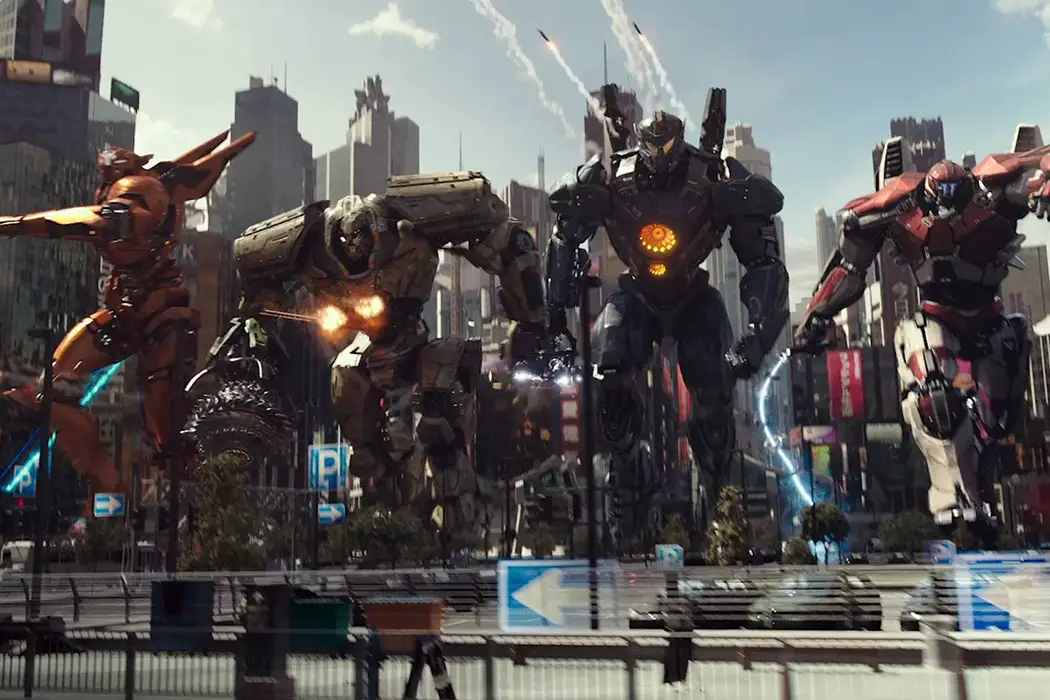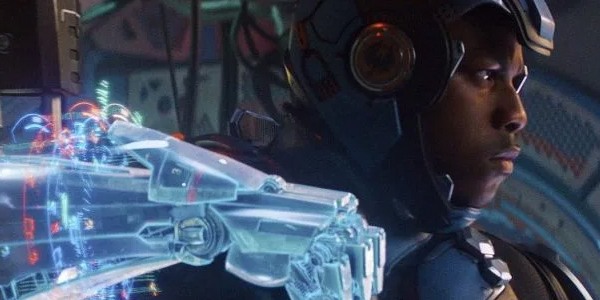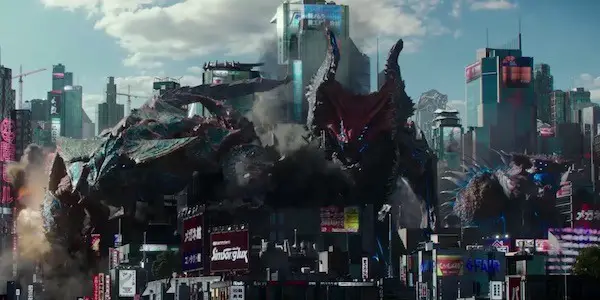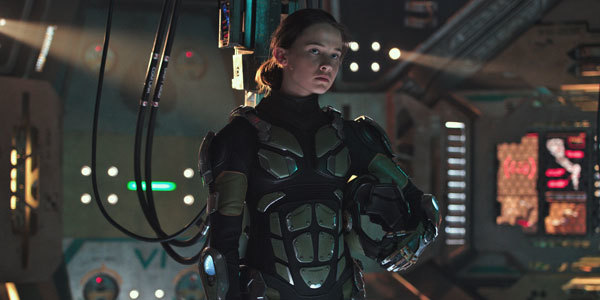PACIFIC RIM: UPRISING: Falls Short Of Rising Up To The Original

Stephanie Archer is 39 year old film fanatic living in…
It is a commonly accepted belief that sequels, more often than not, fail to live up to the standards of their predecessors. Sadly, Pacific Rim: Uprising is no exception. While Pacific Rim had been a pleasant surprise, Uprising fails to bring anything new or interesting a second time around.
From the opening scenes, it is clear that director Guillermo del Toro is no longer at the helm. Where del Toro was playful with the camera, capturing hypnotizing battle scenes and clever in the creation of character, director Steven S. DeKnight fails to rise to the occasion. It does not have the same feeling as the original, and will leave those who enjoyed Pacific Rim feeling cheated.
Pacific Rim: Uprising
It has been ten years since the Battle of the Breach. The world has been rebuilt and the demons from below have been non-existent. Jaegers, manmade machines once created to defeat the Kaiju, have become the staple in the front lines of defense, billions poured into their research and development. Yet, while many have found recovery, others have found a new world rich in crime and black market wealth.

The building of Jaegers has been banned, the private sector craving for what only newly minted criminals can steal. One such thief is none other than the son of Stacker Pentecost (Idris Elba), who gave his life to save the world a decade earlier at the breach. Unwilling to follow in his father’s footsteps, Jake Pentecost (John Boyega) has become one of the best at acquiring desirable black market Jaeger parts for the right price – finding more enemies than deals along the way. Yet, when one of his heists brings him face to face with Amara Namani (Cailee Spaeny), a young self-taught Jaeger tech/hacker, he gets more than he bargained for.
Thrown back into the military fold to avoid a stint in jail, Jake finds that returning to his military roots will prove to be more difficult than ever before as a new Kaiju threat awakens from above the surface, threatening the very existence of mankind.
What went wrong?
Cheesy – I hate using this word to describe a film but this is the one word I have constantly used when speaking of Pacific Rim Uprising. As mentioned earlier on, I was pleasantly surprised how much I had liked Pacific Rim. It had smooth editing, it was well-paced and the story laid within the special effects was solid, lending to cohesive and believable characters. This was all missing in the film’s sequel, leaving a movie that struggles to keep the attention of its audience.
Editing was one of the first ill-fated elements I noticed that differed drastically from the first film. Pacific Rim: Uprising opens to a montage-esque introduction to a world one decade after the Kaiju War and the individuals left to rebuild – specifically our main character Jake. Honestly, the editing and pace reminded me of a modernized ’80s montage – with the soundtrack to back it up. The editing does improve, especially in the battle sequences, yet it still felt rough and choppy, as though no time was taken to polish the final product.
Songs were utilized within Uprising more than the actual score. Many were lined up with montages or battles, sometimes even utilized to infuse humor. Yet, I really found myself missing the score. There was not enough new music to heighten the tension and urgency that Pacific Rim: Uprising was attempting to create. Several times throughout the film, I found myself missing Ramin Djawadi‘s (best known for Pacific Rim, Westworld, Game of Thrones, Iron Man) commanding and solid score that rounded out the success of the original film.

Uprising also suffers from a dulled pace due to over-exaggerated dedication to character and story. Where Pacific Rim was able to strengthen and grow characters throughout the course of its 131-minute run-time, allowing for an even display of story and spectacle, Uprising spends too much time focusing on our main characters and the story. While there is a quasi action scene in the beginning, it is a sold 30-minutes before any real action begins to weave itself into the story. Viewers are forcefed character attributes up until this point, making sure not a bite is missed.
There was one moment, however, I thought was for the keen eye and a clever tributary nod to del Toro. In Pacific Rim, while the Jaeger and the Kaiju are fighting, the manmade weapon is thrown into a building, sliding through each cubicle in the office. Stopping just short of pulverizing the last cubicle, the hand of the Jaeger gently taps one of the metal balls in the Newtown’s cradle on a desk into action.
It is subtle, but a beautifully shot scene, and one I recommend you go back and see if you missed it. In Pacific Rim: Uprising, homage is paid to this scene with a Jaeger once again fighting a Kaiju/ Evil Jaeger. The good Jaeger is throw to the ground, his mechanical body sliding down the streets, pulverizing cars and kicking up a dust of smoke. Stopping just short of the final car, the hand of the Jaeger gently taps it, setting off the car alarm.
This was one of my favorite moments in Uprising, proving it is not all bad. I wish, however, there had been more brilliantly executed tributes to the original. This may have helped the film find more success in its wake.
Serious case of an identity problem
One of the most frustrating aspects of Pacific Rim: Uprising was its inability to identify itself. The original Pacific Rim knew what it was, clearly defined it and stuck to its predetermined boundaries. It was a fight against man and beast, with the ultimate decimation of humanity on the line. Uprising, however, seemed to flow in and out of a variety of other films.

One minute it seemed as though it was Iron Man, another the Transformers, then switching to Powers Rangers before finally settling on Godzilla. While the original shared some similar qualities with these films, it strived to create its own identity – its own enemies with its own good guys to defeat them. Pacific Rim was nothing new, but it was creative. Uprising tries too hard to be inspired by the works of others, failing to be its own creation.
Even its own returning characters, solid in the first film, find themselves different and lacking what had made them captivating and cohesive. While some of the changes in characters were plausible, their execution made them far less credible. One such character was Dr. Newton “Newt” Geiszler (Charlie Day), whose character was reminiscent of a nerdy Always Sunny Charlie, and had a stunning reporee with Dr. Hermann Gottlieb (Burn Gorman).
Both these characters went through a drastic change between the two films, yet while it was plausible the direction each character took, it was not believable. I loved these two characters in the first film, yet found myself disconnected with them and their placement within Pacific Rim: Uprising.
Conclusion
There was so much wrong with Pacific Rim: Uprising that there was little chance it would be able to rise up from its cinematic shortfalls to save itself. While finding a brief glimpse of hope in the homages it tries to pay to the original, Uprising never fully develops a solid pace or a solid structure to justify it.
Did you see Pacific Rim: Uprising? How did you think it sized up against the original? Tell us your thoughts in the comments below!
Pacific Rim: Uprising was released in the US and the UK on March 23, 2018. For all international release dates, see here.
Does content like this matter to you?
Become a Member and support film journalism. Unlock access to all of Film Inquiry`s great articles. Join a community of like-minded readers who are passionate about cinema - get access to our private members Network, give back to independent filmmakers, and more.













